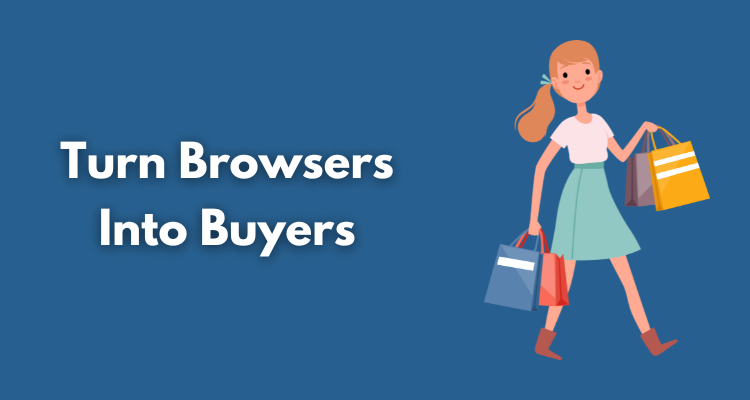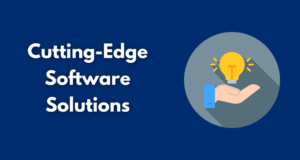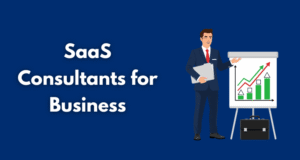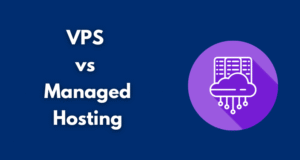Product pages are where your website visitors make the most crucial decision of their browsing journeys: to buy or not to buy. Yet, statistical data shows that the decision usually leans toward the negative outcome.
The average ecommerce conversion rate in 2025 is 1.81%, according to OptiMonk. And even if you can convince prospects to add an item to their carts, their chances of not going through with a purchase are still at a whopping 70.19%.
With this in mind, you’ll want to learn how to turn browsers into buyers. This guide to product page optimization will teach you everything you need to know about boosting conversion rates and provide several examples of brands doing things well to inspire your optimization efforts. Let’s get into it.
Table of Contents
ToggleStart by Improving Page Performance and Responsiveness
Nowadays, web users have zero tolerance and patience for slow and clunky websites. Instead, they want fast and responsive experiences that make it easy to find what they need — regardless of time, location, or screen size.
If you don’t believe that optimizing page performance matters for ecommerce product page conversion rates, check out the data below:
- According to Google, a 10-second rise in
- page load time could increase the chances of a web visitor bouncing by as much as 123%.
- Additionally, 78% of all ecommerce site traffic comes from mobile phones.
Knowing this, it’s clear that you’ll need to invest in your web visitors’ browsing experiences.
Research from PWC suggests that the key lies in providing speed, convenience, and knowledgeable help. So, explore ways to include these on your product pages (as well as on the rest of your site), and you’re guaranteed to have an easier time convincing people to buy.
Explain Your Offer in a Way Your Target Audience Can Understand
Another common conversion killer that may be lurking on your product pages is inefficient copy.
You see, consumers need to understand what solutions do and why that matters to them if they are to convert. And this only gets more important with big-ticket items.
So, if your ecommerce conversion rates leave something to be desired, take a closer look at your product descriptions. Can your target audience understand and relate to them? Or are they too complex to elevate your ideal customers’ purchase intent?
For example, one of the best optimization tactics to boost sales includes improving the readability and accessibility of your product pages.
It’s relatively easy. All you have to do is prioritize brevity and simplicity in your product descriptions. Avoid technical jargon. And don’t be afraid of getting down to basics.
Instead, educate your prospects on what your solutions do and point out how each product benefits potential prospects.
For example, check out how Rogaine does it below. The brand uses a combination of copy and visuals to explain how its solutions work. It provides detailed use instructions and even gives shoppers a transparent “what to expect” section. This boosts purchase intent via the mediating influence of product understanding and helps the brand inspire more conversions.
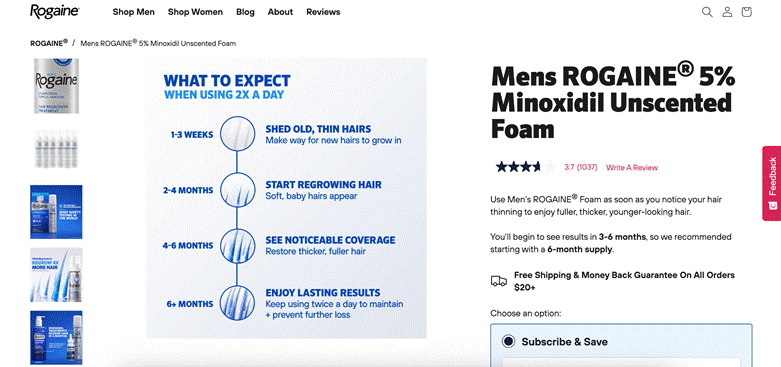
Source: rogaine.com
Of course, if you sell more complex products, then you might have to go into a bit more detail. In this case, do your best to enrich your product pages with any necessary educational materials your potential customers might need to read before buying.
EXT does this on their 10 Foot Outdoor Kitchen page, knowing that most people don’t know about things like HDPE and LockJoint technology. So, instead of letting them leave without converting, the business does its best to make these concepts easy to understand with dedicated educational resources.
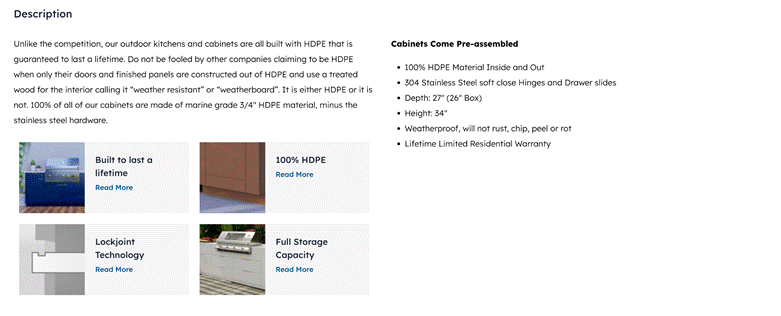
Source: extcabinets.com
Highlight Sought-After CX Benefits
When trying to turn browsers into buyers, one of the best things you can do is focus on what sought-after benefits you can offer potential customers.
We already mentioned that customer experience plays a significant role in inspiring purchases. But, sometimes, the benefits your web visitors want don’t have anything to do with your products. Instead, they’re all about the shopping process and what comes after.
That’s why you need to identify the customer experience perks your target audience seeks. Make sure to make them a part of your offer. And don’t be shy about pointing them out on product pages.
For example, free shipping is a big ask in 2025. So, knowing how important it is to your customers, why not point out that it’s a part of your offer?
If you look at the Golf Cart Tire Supply product pages, you’ll notice that this brand always points out that each product comes with fast and free shipping in the US. This is especially important considering the size and weight of the items this brand sells.
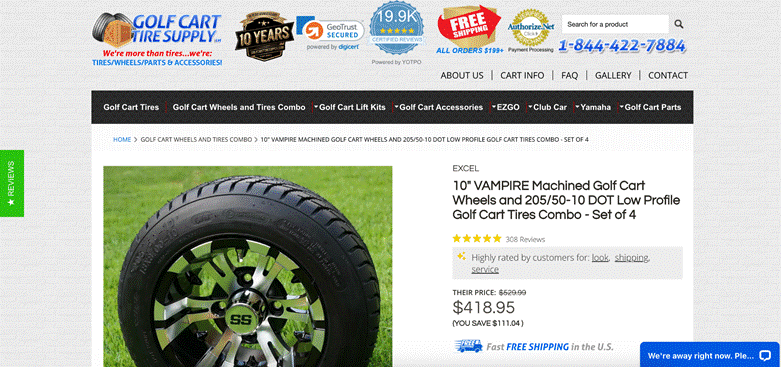
Source: golfcarttiresupply.com
Other CX benefits you could emphasize include free or unlimited returns, lifetime warranty, 24/7 customer support, etc.
Inspire Purchases with Stunning Imagery
Did you know that 75% of online consumers rely on product photography to make buying decisions?
That’s right, the visuals on your website have a huge impact on your conversion rates. And this impact becomes even stronger if you’re selling aspirational products that enable shoppers to acquire a specific feeling or lifestyle.
With this in mind, do your best to enrich your product pages with breathtaking visuals. But don’t just use artistic photos that convey a mood or desired outcome.
Yes, these can be valuable when optimizing for sales. Nevertheless, you also have to ensure that your product photography aids evaluation and analysis.
So, allow web visitors to zoom in on your products, show off multiple angles, and don’t shy away from advanced media formats like videos or AR product try-on features.
For inspiration, check out how The Detox Market does it with its hand cream product page. Knowing how important product texture and feel are to its target audience, this brand smartly includes a close-up of its lotion to make it easier for shoppers to assess what this product feels like and whether that aligns with their wants and needs.
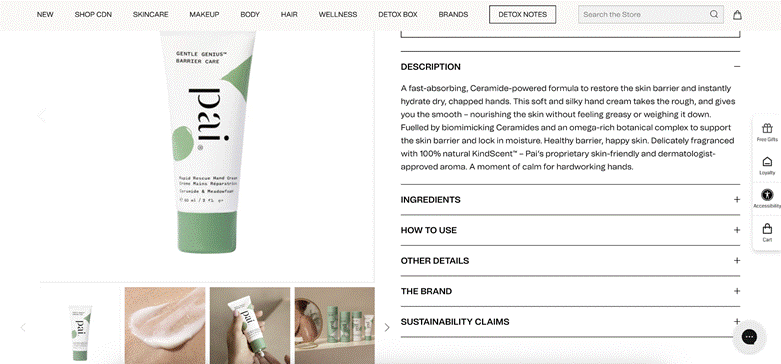
Source: thedetoxmarket.ca
Build Trust and Remove Conversion Obstacles with Social Proof or Trust Signals
Brand trust has a huge influence on consumers’ willingness to click the “Buy” button. According to research from Edelman, brand credibility is the third most important purchase-influencing factor, right after price and quality.
Additionally, almost all consumers incorporate pre-purchase product research in their buying journeys, with 99.75% of them relying on social proof for the process.
With this in mind, your product page optimization strategy needs to align with these consumer priorities. In addition to showing off meaningful social proof, explore additional ways to convince your target audience of your brand’s credibility and expertise.
For instance, knowing that user-generated content makes for one of the most trustworthy content formats, consider adding it to your product pages in a highly visible spot.
Check out how PergolaKitsUSA.com does it. This business expertly combines technical, branded, and UGC visuals in the topmost section of its product pages, with the overall effect being that of a detailed product photo gallery. This optimization tactic allows buyers to see the same solution in several different, real-life contexts. Moreover, it gives them all the info they need to decide if it’s the right option for them.
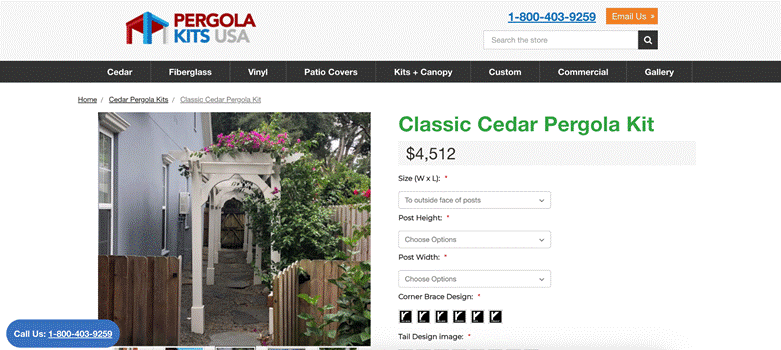
Source: pergolakitsusa.com
Alternative trust and conversion-boosting methods of earning consumer confidence on product pages include using trust signals (like customer logos, which is what SaaS brands usually do).
Or, if you operate in a low-trust industry, you could try something similar to Wild for Salmon, a brand that shows off third-party certificates to highlight that its products are wild-caught and made in the USA.
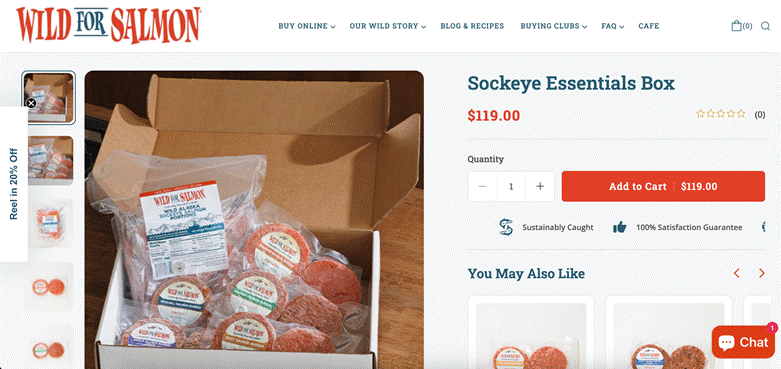
Source: wildforsalmon.com
Think About Customer Retention Early On
The thing about optimizing ecommerce product pages for conversions is that your ultimate business goal shouldn’t be to sell to many customers only once. Instead, the best way to accomplish sustainable business growth and create a reliable cash flow is to set your heart on customer retention.
In fact, most marketing experts agree that selling to existing customers is much easier (and cheaper) than targeting new leads all the time.
If you have a limited marketing budget or simply want to get the highest ROI on all your advertising activity, start thinking about customer retention early on. Plus, it’s great for boosting customer lifetime value.
Now, you can use multiple product page optimization tactics to boost customer retention. But perhaps none of them work as effectively as encouraging repeat purchases (and rewarding customers for being loyal to your brand).
Something as elementary as offering a subscription model — which is not just convenient but often offers savings as well — is one of the best methods of improving conversions in 2025. It takes the decision-making process out of the re-purchasing process for your customers.
And if you’re not convinced that it works, consider this: in 2024, 26% of shoppers used automatic refill subscriptions instead of buying at will.
So, if you sell consumable products, adding a subscription incentive — like the one on the Transparent Labs Grass-Fed Casein Protein product page — is a great tactic. This brand, in particular, tries to convince consumers to subscribe by offering a few valuable perks. The most obvious of these is the discount that return customers get. The brand also throws in free shipping for repeat purchases. Plus, it gives buyers control over how often they receive their products, with three possible delivery frequency options and the ability to pause or cancel at any time.
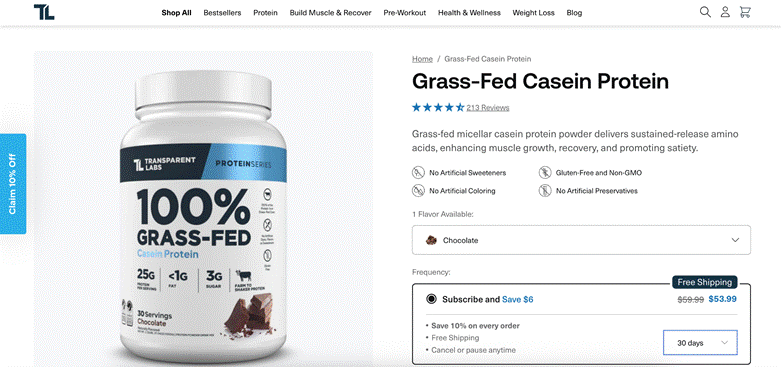
Source: transparentlabs.com
Don’t Overdo It with Urgency Triggers
Finally, if you want to turn more browsers into buyers by optimizing your product pages, don’t use too many urgency triggers.
Sure, these types of conversion-inspiring elements can and do work in most cases. However, their effect is usually short-lived. And when they’re used too aggressively, they harm brand trust, automatically lowering your chances of converting new customers.
So, if you want to boost sales but don’t want to come off as aggressive when trying to nudge web visitors toward a conversion, explore more gentle ways of inspiring your prospects to act.
The 10% off pop-up button on the Allkinds website is a great conversion incentive, even though it doesn’t necessarily boost sales right away. Nevertheless, it works by convincing web visitors to sign up for the brand’s newsletter. That’s equally as valuable — especially as it allows the business to nurture high-value leads into satisfied (and eventually loyal) customers.
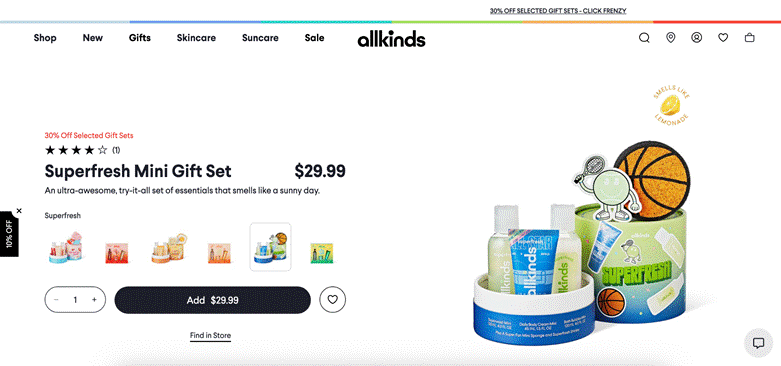
Source: allkinds.com
Final Thoughts
Optimizing your product pages for higher conversion rates doesn’t require reinventing the wheel. Nevertheless, it does necessitate a user-centric approach to designing webpages and customer experiences.
So, if you want to improve your ecommerce sales and convert more new customers, try out the tactics described in this guide. Don’t hesitate to adapt them to your brand’s and target audience’s needs. Lastly, ensure you regularly track progress to guarantee you’re on the right path.
That way, you won’t just see an uptick in your ecommerce conversion rates. You’ll also uncover additional opportunities to delight your ideal customers and unlock the opportunity to build an unmatched CX that your buyers will love to return to in the future.

